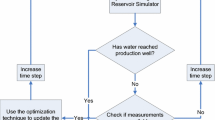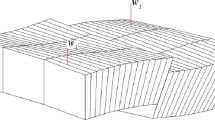To fully exploit the possibilities of “smart” wells containing both measurement and control equipment, one can envision a system where the measurements are used for frequent updating of a reservoir model, and an optimal control strategy is computed based on this continuously updated model. We developed such a closed-loop control approach using an ensemble Kalman filter to obtain frequent updates of a reservoir model. Based on the most recent update of the reservoir model, the optimal control strategy is computed with the aid of an adjoint formulation. The objective is to maximize the economic value over the life of the reservoir. We demonstrate the methodology on a simple waterflooding example using one injector and one producer, each equipped with several individually controllable inflow control valves (ICVs). The parameters (permeabilities) and dynamic states (pressures and saturations) of the reservoir model are updated from pressure measurements in the wells. The control of the ICVs is rate-constrained, but the methodology is also applicable to a pressure-constrained situation. Furthermore, the methodology is not restricted to use with “smart” wells with down-hole control, but could also be used for flooding control with conventional wells, provided the wells are equipped with controllable chokes and with sensors for measurement of (wellhead or down hole) pressures and total flow rates. As the ensemble Kalman filter is a Monte Carlo approach, the final results will vary for each run. We studied the robustness of the methodology, starting from different initial ensembles. Moreover, we made a comparison of a case with low measurement noise to one with significantly higher measurement noise. In all examples considered, the resulting ultimate recovery was significantly higher than for the case of waterflooding using conventional wells. Furthermore, the results obtained using closed-loop control, starting from an unknown permeability field, were almost as good as those obtained assuming a priori knowledge of the permeability field.
Similar content being viewed by others
References
I. Aitokhuehi, L.J. Durlofsky, V. Artus, B. Yeten and K. Aziz, Optimization of advanced well type and performance, in: Proc. 9th European Conference on the Mathematics of Oil Recovery, Cannes, France (2004).
T.M. Apostol, Calculus, vol. 2, 2nd Edition (Wiley, New York, 1969).
H. Asheim, Maximization of water sweep efficiency by controlling production and injection rates, paper SPE 18365, in: Proc. SPE European Petroleum Conference, London, UK (1988).
K. Aziz and A. Settari, Petroleum Reservoir Simulation (Applied Science Publishers, London, UK, 1979).
D.R. Brouwer, Dynamic Water Flood Optimization with Smart Wells Using Optimal Control Theory, Ph.D. thesis, Delft University of Technology (2004).
D.R. Brouwer and J.D. Jansen, Dynamic optimisation of water flooding with smart wells using optimal control theory, SPE J. December (2004) 391–402.
D.R. Brouwer, G. Nævdal, J.D. Jansen, E.H. Vefring and C.P.J.W. van Kruijsdijk, Improved reservoir management through optimal control and continuous model updating. Paper SPE 90149, in: Proc. SPE Annual Technical Conference and Exhibition, Houston, TX, USA (2004).
G. Burgers, P.J. van Leeuwen and G. Evensen, On the analysis scheme in the ensemble Kalman filter, Mon. Weather Rev. 126 (1998) 1719–1724.
G. Evensen, Sequential data assimilation with a nonlinear quasi-geostrophic model using Monte Carlo methods to forecast error statistics, J. Geophys. Res. 99(C5) (1994) 10143–10162.
G. Evensen, The ensemble Kalman filter: Theoretical formulation and practical implementation, Ocean Dyn. 53 (2003) 343–367.
G. Gao, M. Zafari and A.C. Reynolds, Quantifying uncertainty for the PUNQ-S3 problem in a Bayesian setting with RML and EnKF. Paper 93324, in: Proc. SPE Reservoir Simulation Symposium, Houston, TX, USA (2005).
Y. Gu and D.S. Oliver, History matching of the PUNQ-S3 reservoir model using the ensemble Kalman filter. Paper SPE 89942, in: Proc. SPE Annual Technical Conference and Exhibition, Houston, TX, USA (2004).
J.D. Jansen, D.R. Brouwer, G. Nævdal and C.P.J.W. van Kruijsdijk, Closed-loop reservoir management, First Break 23 (2005) 43–48.
R.E. Kalman, A new approach to linear filtering and prediction problems, Trans. ASME, J. Basic Eng. 82(Series D) (1960) 34–45.
D.G. Luenberger, Introduction to Dynamic Systems (Wiley, New York, 1979).
G. Nævdal, T. Mannseth and E.H. Vefring, Near-well reservoir monitoring through ensemble Kalman filter. Paper SPE 75235, in: Proc. SPE/DOE Thirteenth Symposium on Improved Oil Recovery, Tulsa, OK (2002).
G. Nævdal, T. Mannseth and E.H. Vefring, Instrumented wells and near well reservoir monitoring through ensemble Kalman filter, in: Proc. 8th European Conf. on the Mathematics of Oil Recovery, Freiburg, Germany (2002).
G. Nævdal, L.M. Johnsen, S.L. Aanonsen and E.H. Vefring, Reservoir monitoring and continuous model updating using ensemble Kalman filter, SPE J. 10(1) (2005) 66–74.
K.M. Overbeek, D.R. Brouwer, G. Nævdal and C.P.J.W. van Kruijsdijk, Closed-loop waterflooding, in: Proc. 9th European Conference on the Mathematics of Oil Recovery, Cannes, France (2004).
P. Sarma, K. Aziz and L.J. Durlofsky, Implementation of adjoint solution for optimal control of smart wells. Paper SPE 92864, in: Proc. SPE Reservoir Simulation Symposium, Houston, TX, USA (2005).
P. Sarma, L.J. Durlofsky, K. Aziz and W.H. Chen, Efficient real-time reservoir management using adjoint-based optimal control and model updating, Comput. Geosci. (2005), DOI: 10.1007/s10596-005-9009-z.
R.F. Stengel, Optimal Control and Estimation (Dover, New York, 1994).
B. Sudaryanto and Y.C. Yortsos, Optimization of fluid front dynamics in porous media using rate control. I. Equal mobility fluids, Phys. Fluids 12(7) (2000) 1656–1670.
G.A. Virnovski, Water flooding strategy design using optimal control theory, in: Proc. 6th European Symposium on IOR, Stavanger, Norway (1991) pp. 437–446.
Author information
Authors and Affiliations
Corresponding author
Rights and permissions
About this article
Cite this article
Nævdal, G., Brouwer, D.R. & Jansen, JD. Waterflooding using closed-loop control. Comput Geosci 10, 37–60 (2006). https://doi.org/10.1007/s10596-005-9010-6
Accepted:
Published:
Issue Date:
DOI: https://doi.org/10.1007/s10596-005-9010-6




